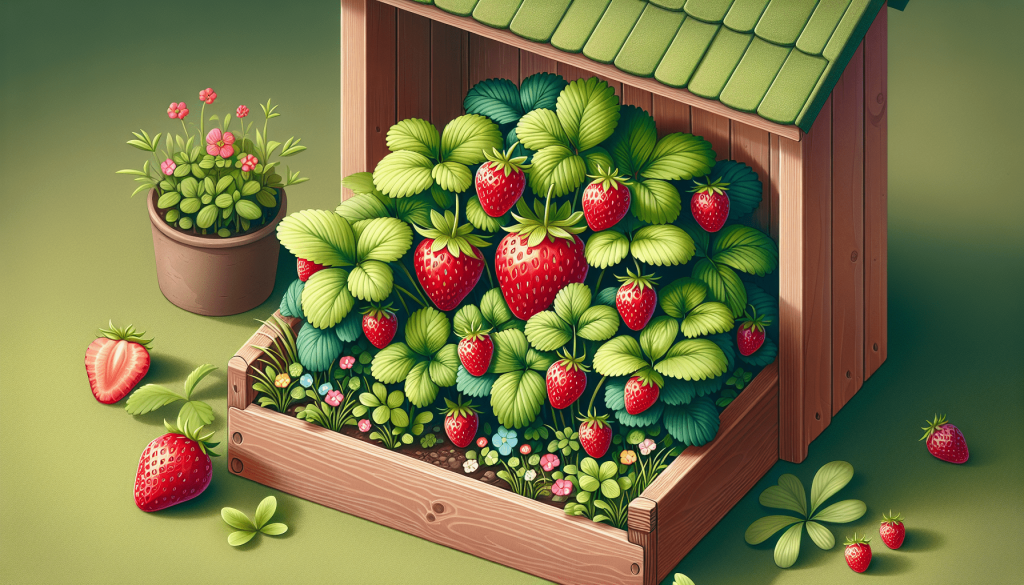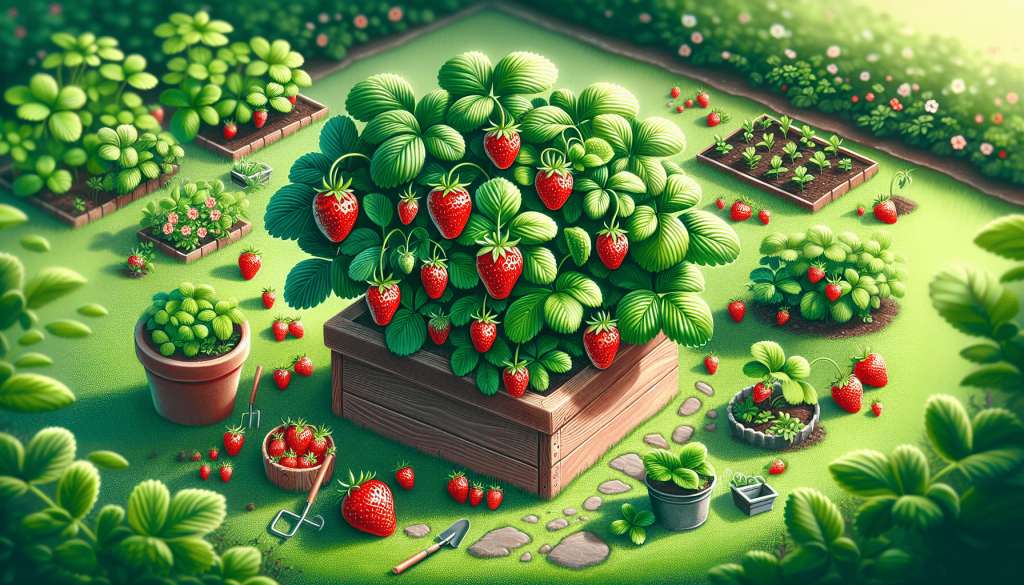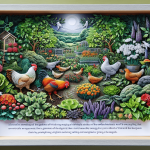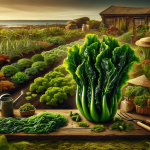This post may contain affiliate links. As an Amazon Associate, we may earn commissions from qualifying purchases.
How can I grow strawberries in a small garden? It’s a question that many garden enthusiasts find themselves pondering, especially when space is limited and the craving for fresh, homegrown strawberries is undeniable. Fear not; whether you’re working with a cozy patio, a small urban backyard, or even a balcony, growing strawberries is well within your reach. Let’s chat about how to make that dream a reality.

Why Grow Strawberries in a Small Garden?
Strawberries are a favorite fruit for many reasons. They’re delicious, versatile in the kitchen, and relatively easy to grow. Plus, there’s something immensely satisfying about plucking a ripe strawberry straight from your garden. When space is an issue, strawberries are an excellent choice because they don’t need acres of land to thrive. They can grow in containers, hanging baskets, or even vertical planters, making them perfect for small gardens.
Choosing the Right Strawberry Variety
Not all strawberries are created equal, especially when it comes to growing them in limited space. Strawberries generally fall into three categories: June-bearing, everbearing, and day-neutral.
| Type | Characteristics |
|---|---|
| June-bearing | Produce a large crop over a 2-3 week period, typically in late spring or early summer. Excellent if you want to make jam. |
| Everbearing | Produce two main crops, one in early summer and another in early fall. Ideal for consistent harvest but less productive overall. |
| Day-neutral | Produce fruit throughout the growing season. They yield fewer berries at a time but offer an ongoing supply. |
Consider your needs and preferences. If you want a big harvest at once, June-bearing might be your best bet. For a steady supply of berries, go for everbearing or day-neutral varieties.
Selecting the Ideal Location
Strawberries love sunlight. They need at least 6-8 hours of direct sunlight daily to produce fruit. So, selecting the sunniest spot in your small garden is crucial. Ensure the location has good air circulation to reduce the risk of fungal diseases.
Soil Considerations
Strawberries prefer slightly acidic soil with a pH between 5.5 and 6.8. The soil should be well-draining to prevent root rot. If you’re unsure about your soil’s quality, consider getting a soil test kit from your local garden center.
Adding Organic Matter
Incorporating organic matter like compost into your soil can boost fertility and drainage. If you’re using containers, mix the potting soil with compost to provide the necessary nutrients.
Planting Techniques for Small Spaces
Now that we’ve got the preliminaries out of the way, let’s focus on the nitty-gritty of planting strawberries in small spaces. Here are some methods tailored to those restricted by space but inspired by the potential for a fruitful garden.
Container Gardening
Containers are a fantastic option for growing strawberries in small gardens. You can use pots, hanging baskets, or specialized strawberry planters. The key is to ensure they have good drainage.
- Prepare the Container: Select a pot at least 12 inches in diameter. Fill it with a high-quality potting mix blended with compost.
- Planting: Space your strawberry plants about 10-12 inches apart. Ensure that the crown (the part where the stem meets the roots) is slightly above the soil line.
- Watering: Water thoroughly after planting and keep the soil consistently moist but not waterlogged.
Vertical Gardening
Vertical gardening is another space-saving technique that’s perfect for small gardens. This method involves growing plants on structures like trellises, walls, or in tiered planters.
- Choose Your Structure: You can purchase ready-made vertical planters or get creative with DIY options like repurposed pallets or gutters.
- Planting: Make sure your vertical garden gets enough sunlight. Mix potting soil with compost and plant your strawberries, ensuring proper spacing.
- Maintenance: Watering can be a bit tricky with vertical gardens. Aim to keep the soil moist and check the upper and lower levels for consistent moisture.
Raised Beds
If you have a tiny patch of ground, consider a raised bed. Raised beds warm up earlier in the spring, provide good drainage, and allow for better soil control.
- Constructing the Bed: Aim for a bed that’s at least 6-12 inches deep. Fill it with a mix of garden soil, compost, and peat moss.
- Planting: Space your strawberry plants about 12 inches apart. Be mindful of the crowns, keeping them just above the soil.
- Irrigation: Raised beds dry out faster, so regular watering is essential. Mulching can help retain moisture and keep weeds at bay.

Caring for Your Strawberry Plants
Planting is just the beginning. Strawberries need a bit of TLC to grow into healthy, fruitful plants. Here’s what you need to keep your strawberry plants thriving.
Watering
Strawberries have shallow root systems, which means they dry out quickly. Water your plants consistently, aiming for about an inch of water per week. Be cautious not to overwater, as soggy soil can lead to root rot.
Fertilizing
Strawberries benefit from regular feeding. Use a balanced, all-purpose fertilizer to keep the plants well-nourished. Here’s a simple fertilization schedule:
- Early Spring: Apply a balanced fertilizer (such as 10-10-10) when new growth appears.
- Mid-Summer: During the growing season, use a high-potassium fertilizer to encourage fruiting.
Mulching
Mulch is your strawberry plants’ best friend. It helps retain moisture, suppress weeds, and keep the fruit clean. Straw is a popular choice, but you can also use pine needles or leaf mulch.
Pruning/Maintenance
Strawberries produce runners (shoots that develop new plants) to propagate. While this is excellent for creating new plants, it can overcrowd your garden. Trim runners as needed, or let them root if you wish to expand your strawberry patch.
Pest and Disease Management
Every garden faces its challenges, and strawberries are no exception. Being aware of common pests and diseases can help you take preventive measures.
Common Pests
- Aphids: Tiny insects that suck sap from plants.
- Slugs and Snails: These critters love moist conditions and can eat holes in your strawberries.
- Birds: Birds can be a significant problem as they love strawberries as much as you do.
Solutions
- Introduce beneficial insects like ladybugs to control aphids.
- Use beer traps or copper tape to deter slugs and snails.
- Protect your strawberries with bird netting or scare tactics like shiny objects.
Common Diseases
- Gray Mold (Botrytis): Look for fuzzy gray growth on fruit.
- Powdery Mildew: White, powdery spots on leaves.
- Verticillium Wilt: Causes leaves to wilt and can kill the plant.
Solutions
- Ensure good air circulation around plants.
- Avoid overwatering and water plants at the base.
- Rotate crops to reduce the risk of soil-borne diseases.
Harvesting Your Strawberries
Arguably the most rewarding part of growing strawberries is the harvest. Knowing when and how to pick your strawberries ensures you enjoy the fruits of your labor at their best.
When to Harvest
Strawberries are best harvested when they are fully red. Pick them early in the morning, when they’re cool and firm, for the best flavor.
How to Harvest
Gently grasp the stem about half an inch above the berry and pinch it off. Avoid pulling the fruit, as this can damage the plant and the berry.
Extending Your Harvest
If you’re looking for a way to enjoy strawberries beyond the typical growing season, there are methods to extend your harvest.
Successive Planting
Plant a combination of June-bearing, everbearing, and day-neutral varieties to prolong your harvest. This way, you can enjoy strawberries from late spring through the fall.
Using Row Covers
Extend the growing season by using row covers to protect your plants from early frost in the spring and late frost in the fall. These covers create a warmer microclimate for your strawberries.
Overwintering Strawberries
Strawberries are perennial plants, which means they can come back year after year with the right care.
-
In-Ground Plants:
- Mulch heavily with straw or leaves after the first frost.
- Remove mulch in spring when new growth starts.
-
Container Plants:
- Move containers to an unheated garage or shed.
- Water sparingly throughout winter, just enough to keep the soil from drying out completely.
Troubleshooting Common Problems
Even the most well-tended gardens can encounter issues. Below are some troubleshooting tips for common strawberry growing problems.
Yellow Leaves
Yellow leaves can indicate several issues, such as nutrient deficiency, overwatering, or pests. Ensure proper fertilization and check for signs of pests or disease.
Small or Misshapen Fruits
This can result from poor pollination, insufficient water, or nutrient imbalances. Ensure your plants receive adequate water and nutrients, and consider hand-pollinating flowers if pollinators are scarce.
No Fruit
If your plants are healthy but not producing fruit, they may not be getting enough sunlight, or they might be too crowded. Ensure they receive plenty of light and have adequate space to grow.
Enjoying Your Homegrown Strawberries
After all the effort, it’s time to enjoy the fruits of your labor—literally! Fresh strawberries are delightful on their own, but there are many ways to savor them.
Simple Recipes
- Strawberry Shortcake: Layer fresh strawberries with shortcake and whipped cream.
- Strawberry Salad: Mix fresh strawberries with spinach, goat cheese, and a balsamic vinaigrette.
- Homemade Jam: Preserve your harvest with a simple strawberry jam recipe.
Sharing the Bounty
Homegrown strawberries make delightful gifts. Share a punnet with neighbors, or invite friends over for a strawberry-themed brunch.
Final Thoughts
Growing strawberries in a small garden might seem like a big task, but with a bit of planning and regular care, it’s entirely achievable. From choosing the right variety to enjoying the rewards of your harvest, each step brings you closer to delicious, homegrown strawberries. So, why not give it a go? Your small garden has the potential to yield big flavors and even bigger smiles.








